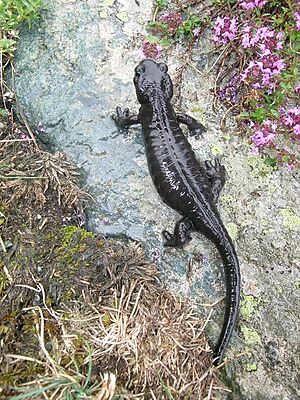Lanza's alpine salamander facts for kids
Quick facts for kids Lanza's alpine salamander |
|
|---|---|
 |
|
| Conservation status | |
| Scientific classification | |
| Genus: |
Salamandra
|
| Species: |
lanzai
|
The Lanza's alpine salamander (Salamandra lanzai) is a special type of salamander found in the high mountains of France and Italy. It's also known as the large alpine salamander. These cool creatures live in forests, grasslands, and pasturelands where the weather is mild. Sadly, their homes are shrinking, which puts them at risk. They also face a potential threat from a dangerous fungus.
Contents
About the Lanza's Alpine Salamander
This salamander was first described by scientists in 1988. Its scientific name, Salamandra lanzai, means "salamander" in Greek. The "lanzai" part honors Benedetto Lanza, an Italian scientist who studied reptiles and amphibians.
What Does It Look Like?
The Lanza's alpine salamander has a flat head. It can grow to be about 11.5 to 16 centimeters (about 4.5 to 6.3 inches) long. Its tail can be rounded or pointed. This salamander is completely black. Because of its dark color, it looks a lot like another type of alpine salamander (Salamandra atra).
Where Do They Live?
You can find these salamanders in the Cottian Alps, which are mountains near Monviso. They also live in the Guil Valley in southeastern France. In northwestern Italy, they are found in the Germanasca, Pellice Valleys, and near the Po River. Scientists are not sure if they live in the Chisone Valley. There's also an old sample in a museum in Florence that suggests they might live in the Maritime Alps too.
What Do They Eat?
Lanza's alpine salamanders are carnivores. They enjoy a diet of various insects, spiders, and different kinds of slugs. They are important for keeping insect populations in check in their habitat.
Their Mountain Home
These salamanders live at high altitudes, usually between 1,200 and 2,600 meters (about 3,900 to 8,500 feet) above sea level. The highest they've been found is around 2,800 meters (about 9,200 feet). In France, they are often seen between 1,800 and 2,300 meters. In Italy, they live a bit lower, from 1,450 to 2,100 meters. They like subalpine prairies, which are grassy mountain areas. They also live in cool, damp woods and forests, and along the edges of mountain streams.
Reproduction and Life Cycle
Lanza's alpine salamanders start their mating season on land. This usually happens from May to October. During this time, they mostly come out at night. However, if it rains a lot, you might see them during the day. Mating mostly happens in May, but it can change depending on the weather that year.
After mating, the female salamander carries her young for a very long time. It can take three to four years for the babies to develop inside her! When they are born, there are usually two to six young. They are born fully formed, looking like tiny versions of the adults.
How They Protect Themselves
Lanza's alpine salamanders are toxic. This means they can release a liquid toxin from small openings on their bodies when they feel threatened. This liquid is strong and can cause irritation if it gets into someone's eyes. To warn predators, they will raise their bodies and dip their heads down. This pose tells other animals to stay away!
Who Are Their Predators?
Even with their toxins, Lanza's alpine salamanders have predators. Various birds and viper snakes are known to hunt them.
Conservation Status
The Lanza's alpine salamander is quite common in the small area where it lives. However, because its home range is so tiny, it was once listed as a vulnerable animal. This means it was at risk of becoming endangered.
In 2022, its status changed to critically endangered by the IUCN Red List. This is a very serious classification. The main reason for this change is a dangerous fungal disease called Batrachochytrium salamandrivorans. This fungus has been found in nearby areas, like Germany. Scientists are worried that if this fungus spreads naturally, the Lanza's alpine salamander could face extinction within the next 40 years. If humans accidentally spread the disease closer, it could happen even faster. Protecting their habitat and preventing the spread of this fungus are very important for their survival.


